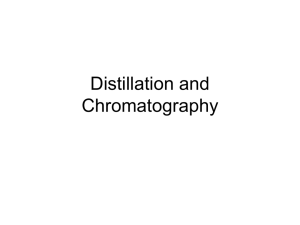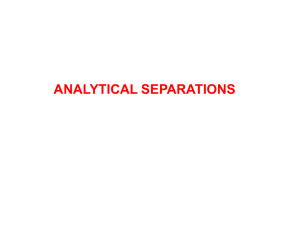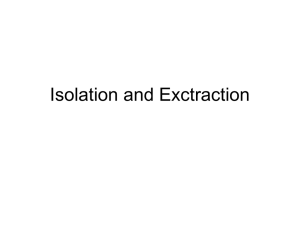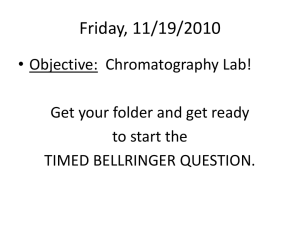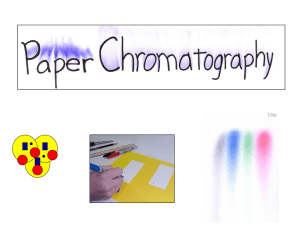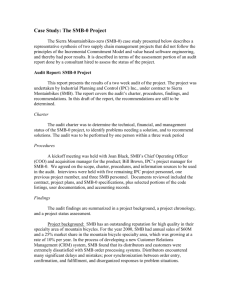The amazing ability of continuous chromatography to adapt to a
advertisement
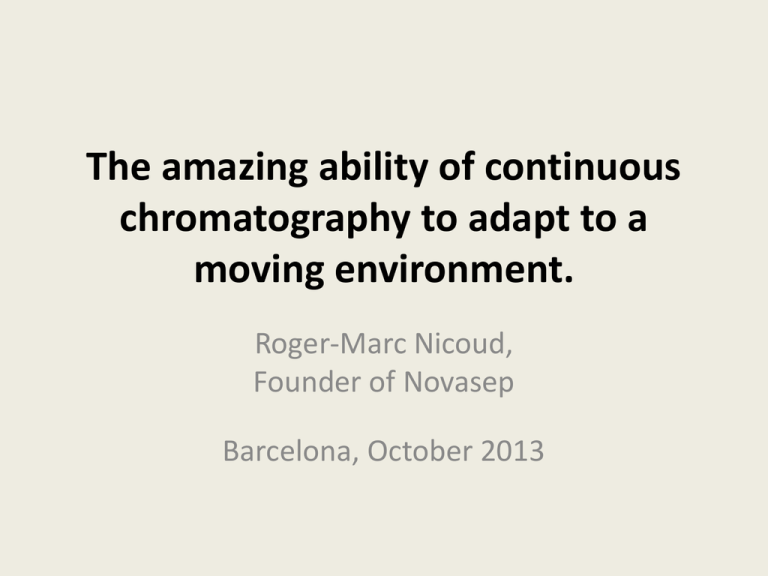
The amazing ability of continuous chromatography to adapt to a moving environment. Roger-Marc Nicoud, Founder of Novasep Barcelona, October 2013 Introduction My thesis: the environment pressure pushes Continuous Chromatography to evolve like animals evolved according to Darwin’s law …. and for that, I will use shortcuts , approximations and manipulations … Improving what ? Counter-current can help Continuous can help System size Eluent consumption Yield Operations Comment Productivity kg/kg/day normally presented as the main objective function Minimizing solvent consumption (prior to recycling) is a must in all large scale applications. Can be a major cost contributor Control / Process Stability / Cleaning can be critical costs contributors. Mitigation large LP systems can be cheaper than smaller HP systems Biopharma industry still a bit less concerned Ancillary equipment is even more important than chromatography itself. Life is often a matter of compromize Continuous is NOT synonymous with counter-current A continuous but NOT counter-current animal Be careful with comparisons Productivity kg/kg/d 12 10 8 Optimum particle size, eluent composition … are different for Batch and continuous/CC processes. 6 4 2 0 Batch My clever process S.M.B.: the key evolution ….. Evolution lead to the first continuous AND counter-current animal solid Maximize productivity liquid IV III Feed II I Eluent The first evidence of continuous chromatography Environment pressure : Paraxylene • Scale (500,000 Mt/Y/Unit in 2010) • Chromatographic conditions: – Selectivity about 2 – Particle size about 1000 microns (inducing “poor” HETP ….) – Temperature about 180 °C (inducing low viscosity) • Technical constraints – Target purity: > 99.8 % – “individual bed length” : limited to 1 m due to mechanical constraints significant bed length of 24 m (no pb because of low viscosity) 24 columns to reach total length Environment pressure : Fructose • Scale (50,000 Mt/Y/Unit in 2010): from Glucose-Fructose mixtures • Chromatographic conditions: – Selectivity about 1.5 – Particle size about 300-500 microns (inducing “poor” HETP) – Temperature: 60 °C (thus viscosity about 10 cp ) • Technical constraints – Target purity: about 90 % – Minimize energy consumption for evaporating Water total bed length of about 8-12 meters Improving the classical SMB • Add some degree of freedom by: – Connecting columns in different ways – Selecting different switching modes – Varying I/O lines composition and flows • New processes are normally: – quasi-continuous instead of being truly continuous – taking advantage of «counter-current» contact Fructose: further improvement A new animal Two sub periods «Cousin animals»: • SSMB Novasep • ISMB Mitsubishi Commercial solutions implemented: • 4 or 6 columns • Eluent consumption decreased by about 10-15 % compared to SMB Environment pressure : optical isomers • Scale (1-100 Mt/Y/Unit in 2010) • Chromatographic conditions: – Selectivity: typically between 1.2 and 2 – Little influence of particle size on packing cost – HETP depending on particle size … • Technical constraints – Target purity: 95-99 % – Minimize system size / CSP inventory Use small particle size Total bed length about 0.5 m …. To be distributed between Ncol … At large scale L/D < 0.1 ….. The first SMB animal for separating optical isomers (1992): Influence of petrochemical design is very visible …. and the modern version …. Optical isomers: further improvement VariCol VariCol: • Truly continuous • Same hardware as SMB • Typically saves one column out of 5-6. Key successes For main successes, continuous chromatography is coupled with crystallization, isomerization and multiple effect evaporators Very large scale does not mean « second-class » performance In Line Dilution is key Environment pressure : need for multicomponent (bio)separations. The generic purification problem : An animal with no progeny ? VIII VII Technically one can design a continuous three pure fractions TMB. VI Prefer two SMB in series : Paclitaxel, Cyclosporine, EPA … W P S time reduces to a binary separation if one wants or change … the green or the concept red product. SMB is perfectly adapted to these situations (ex.: desalting, xylenes, capture …), V IV III II I Imposes to work with two suboptimal systems ? Improving multicomponent separations MCSGP (Multicolumn Countercurrent Solvent Gradient Purification) from ETH. VI P+W V W W • • • Feed P IV S P+S P III II S I Important features of the animal: Opening liquid loop Short-circuit Gradient A truly continuous gradient chromatographic process with 6-columns 3-column MCSGP Two sub periods VI P+W VV VI W P+W V “Cousin animal” from Novasep : GSSR IV IV Gradient (with) Steady-State Recycling P+S III P II P+S III II S I I Can be done with three columns Not strictly continuous but counter current Environment pressure : need for capturing (biomolecules) Selectivity is such that a solvent change is mandatory t Loading Washing Elution W Non retained P S Very strongly retained tcycle Regeneration Equilibration Bioseparations: the BioSc concept Two sub periods W Feed Wash W Wash * W animals” from : “Cousin • • Chromacon (Capture SMB) GE (3C PCC) Wash P Target Elute P Target Elute S Regenerate S Regenerate Waste Equilibrate W Waste Equilibrate Use sequential feeding to reduce the number columns (as low as two). Lysine production main steps FERMENTATION MEMBRANE FILTRATION BIOMASS ION EXCHANGE PURIFICATION About 50,000 MT/year/unit ACIDIFICATION EVAPORATION CRISTALLISATION CRUDE L LYSINE HCl Lysine purification: switch from batch to continous (a decade ago) • First step: Strong Cation Exchange • Feed pH 3-4 so that Lys+ (maximizes loading and separation) • Then pH lowered to 1-2 so that Lys++ (maximizes capture of small concentrations) • Wash • Elution by ammonia at pH 9 (Lys0) • Ammonia recycled through stripping 97% Lys with microbial byproducts and mineral cations • Second step: Weak Cation Exchange • Feed at pH 9 (Lys0 goes through) • Regeneration at pH with diluted sulphuric acid • Wash Gain continuous (about 10-column systems) vs Batch: resin inventory and effluent divided by about 3 Biopharma Many proof of concept published: • mAbs • pegylated proteins • peptides • fatty acids ….. Still looking for a first Biopharma industrial application of continuous chromatography ? Evolution …. Continuous character Xylene 100 % Number of columns 24 Sugars 12 I-SMB S-SMB 6 VariCol MCSGP 4 1960 1980 2000 MCSGP GSSR BioSc 3C PCC 50 % 2 2010 2020 ? Thank you ! Process integration may lead to non intuitive processes … Intuition Glu 90 % Glu 95 % Isomerization Glu-Fru 58-42 S M B HFS 55 % Optimized Glu 90 % Glu 95 % Isomerization Glu-Fru 58-42 S M B Fru 90 % HFS 55 %

